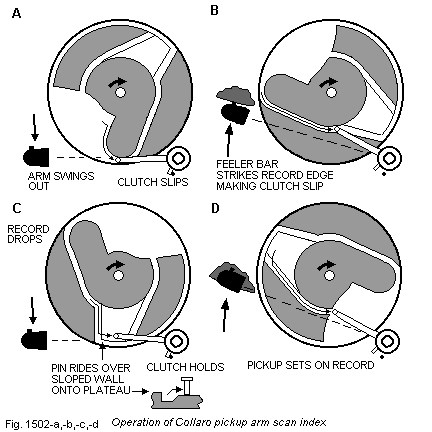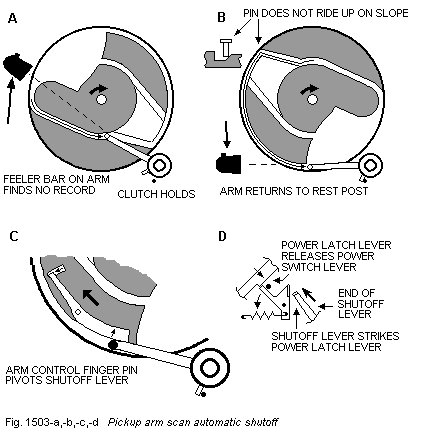My favorite record changer is the Collaro Conquest. Appearing in several different forms, it is one of the most useful record changers around. Standard features include:
- Automatic size sensing of all records from 12" to 7", including odd sizes.
- Automatic play of nonstandard-sized records.
- Automatic arranged size intermix - Records must be stacked with larger discs before (under) smaller discs.
- Automatic stylus protection. If the unit is started without a record, the arm will return to the rest post automatically.
- Velocity trip works on almost all records. Only those without finishing grooves will not trip the change cycle.
- Manual start if desired.
- A constant change cycle time, independent of record speed.
- The change cycle will operate even if the speed is set to neutral.
- The spindle lowers the record stack to the spindle ledge after dropping the record, instead of letting the stack drop.
- Ability to use 3.5" repeating discs, provided that each repeating disc is between two records the same size.
- Ability to use the large-hole spindle adaptor without the overarm being on the records.
The 4 photos show (in sequence) my Collaro Conquest at rest, feeling a 7" record, playing the 7" record, and feeling the absence of records at the end of the stack.
The pickup arm itself is used to feel the record size. During the change cycle, the pickup arm rises from the record and swings out over the restpost, clear of the record stack. It then does something a little different from what most other record changers do. Before the record drops, the arm rises up to the height of the unplayed stack, and moves toward the records on the spindle. If there are records on the spindle, the feeler bar on the left side of the pickup head strikes them, measuring very accurately the diameter of the largest record in the stack. This, of course, means that larger records must be placed before smaller records in the stack.
After the arm feels the size of the record, it returns to a position over the restpost, and the record drops. Then the arm lowers down below the records on the spindle, swings in over the starting groove of the record that dropped, and sets down on it. If the arm doesn't find a record when it feels for one, then it stays over the restpost when it swings out the second time, and the power shuts off as the arm sets on the post.
With very little work, I added the following features to my TSC-640/200 to make the TSC-640/1019A.
- Full manual start - cannot trip the change cycle while activated (requires one piece of piano wire). Operated by holding in the PLAY control (existing small black lever on left front) while moving the pickup arm manually. Once the PLAY control is released, the changer is again enabled to trip at the end of the record.
- Extension of the size scan to include automatic play of 6" records (works with the narrow head arms - no parts).
- Extension of arm travel to include playing 4" Hip Pocket records (no parts). This record is too small to index automatically, but after being started with the manual modification, the record will play, and the changer will trip when it is over
- Changing the overarm so it does not drop below the spindle ledge, and making the overarm removable (no parts).
- Quieter running motor, greatly reduced rumble (3 grommets).
- Quieter running turntable (one Garrard turntable center bearing).
- Modification of the arm to track at 2 grams (one special washer made on a lathe, one Garrard turntable center bearing). Notice that nothing has to be done to the change-cycle mechanism to achieve this. The design of the trip and arm handling parts was good enough when the changer was made.
- Modification of arm to take Shure M-44E cartridge (some sheet brass, parts from different Shure cartridges, and a new cast lead counterweight).
- Antiskating (one 8-32 screw, 3 8-32 nuts, rivets, solder, and some scrap brass sheet and rod stock). Visible to the right of the pickup arm base in the photos
- Cue control (works on only pre-Micromatic models - washers, one compression spring, #14 Romex scrap, and some scrap brass sheet and rod stock). This is visible at the right front in the photos.
- Turntable stop - causes the turntable to slow down and stop rotating while the record drops (only pre-Micromatic models - scrap copper and brass sheet and rod stock, washers, rivets, screw hardware, springs, and one rubber foot).
- That nice base (some old wood cabinet doors, hardware, some Masonite, and 4 rubber feet). It has storage wells for the large-hole spindle and the removable overarm.
- Electronic pitch control (mounted in base at rear).
- A modified Autocleanica mounted on the base at the rear.
- Autospeed automatic speed change - allows 7" 45 RPM records to follow 12" and 10" 33 RPM records (requires the turntable-stop modification, copper and brass sheet and rod stock, springs, screw hardware, #14 Romex scrap, rivets and a pickup arm shaft from a broken V-M 935 - a piece of brass tubing will do). This mod is visible as the brass feeler arm behind the overarm in the photos.
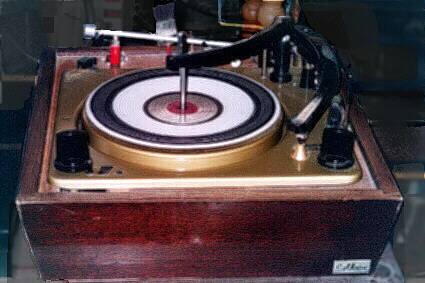
My Collaro TSC-640/1019A Conquest at rest
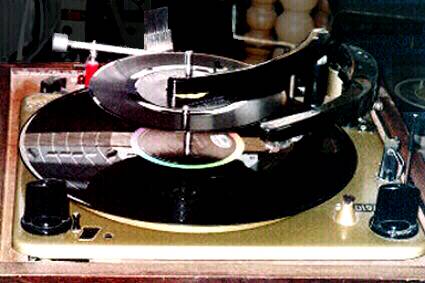
Feeling the size of a 7" record
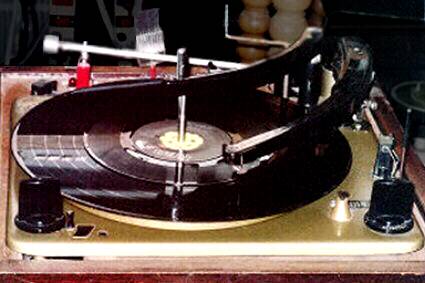
Setting the pickup down on the 7" record
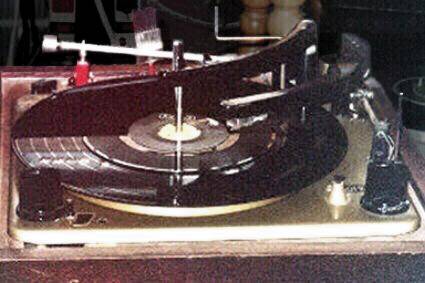
Feeling the absence of a record for automatic shutoff
Autospeed is activated by starting my Collaro Conquest in 33, holding the Automatic control in the REJECT position, then changing the speed control to 45, and then releasing the Automatic control. If you do not know that Autospeed is there, you will not even notice it unless you try to change speed after starting a record stack. During each change cycle, the brass feeler arm comes toward the spindle just after the arm rises from the record that finished playing. It contacts any record larger than 9" that is up on the spindle. If the brass feeler arm contacts a record and Autospeed is active, the speed will stay at 33 RPM. If it does not contact a record, the speed automatically changes to the current setting of the speed control. Autospeed never persists beyond one stack of records, unless the stack is stopped by hand. If this occurs, starting a change cycle with no records on the spindle will clear Autospeed.
The 45 spindle is used in an unusual way on the Collaro Conquest. The instructions say to place the overarm on top of the 45 adaptor (upper right), not on the records. This is because placement of the overarm on the records caused the records to tilt on this kind of adaptor, sometimes causing a record to not drop. And leaving the overarm over the restpost can cause the arm to snag the overarm when scanning for record size. Placing the overarm on top of the adaptor keeps it out of the way.
Note also that the older design has a hole in the overarm that slips over the spindle (middle right). Putting the overarm on the adaptor also works with this type of overarm.
If the modification I made is done on the overarm, removing it is also an option.
There is a way to achieve full manual start on any Collaro Conquest without the above modification:
- Place the record on the turntable and the pickup arm on the rest post.
- Turn off the changer (Automatic control to Stop or Off).
- Rotate the turntable backwards (counterclockwise) at least one rotation.
- With the changer still off, lift the arm by hand and move it as close as it freely goes to the spindle.
- Move the arm away from the spindle just enough to place it in the desired place on the record. If you move it too far away from the spindle, move it close to the spindle and try again.
- Place the stylus on the record.
- Turn on the turntable without starting a change cycle. Use the ON, PLAY, or MAN position, depending on the changer version used. The record will play. If the record has a finishing groove, the changer will trip at the end of the record. If it does not, turn the Automatic control to Reject.
This process is not needed for normal band selection on a normal record. It is needed if the record is very small or if there are many small bands close to the spindle.
Repeat this process every time a starting location very close to the spindle is needed.
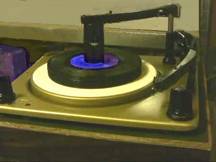
45 Spindle use on Collaro Conquest TSC-640/200
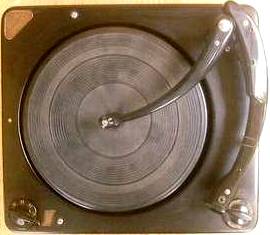
An older Collaro Conquest TC-640
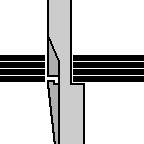
Collaro Conquest spindle

